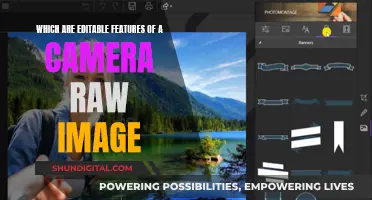
Many cameras allow users to save images in both JPEG and RAW formats simultaneously. RAW files are often preferred by professional photographers as they capture uncompressed data from the camera sensor, resulting in higher image quality. However, this comes at the cost of larger file sizes. On the other hand, JPEG files are compressed versions of RAW files, making them more storage-efficient and convenient for quick sharing. Some cameras may also have issues displaying RAW images, requiring the use of JPEGs for immediate viewing.
| Characteristics | Values |
|---|---|
| File format | RAW and JPEG |
| File size | RAW files are larger than JPEG files |
| Image quality | RAW files have higher image quality than JPEG files |
| Data | RAW files capture more data than JPEG files |
| Processing | RAW files require more processing than JPEG files |
| Storage | RAW files require more storage than JPEG files |
| Editing | RAW files offer more editing flexibility than JPEG files |
| Standardization | JPEG is a standardized format, RAW is not |
| Compatibility | JPEGs are compatible with most image editors, RAW files require specific software |
| Speed | RAW files take longer to process than JPEG files |
What You'll Learn

RAW files are larger than JPEGs but hold more usable data
RAW files are uncompressed and contain all the data captured by the camera's sensor. This results in files that are much larger than JPEGs. A 16-megapixel camera, for example, will produce a 16 MB RAW file.
JPEGs, on the other hand, are compressed and processed versions of an image. The camera adjusts the saturation, contrast, vibrance, and/or sharpness of the RAW data before compressing it down to 8 bits. This compression results in a significant reduction in file size, but it also means that a lot of data is lost.
RAW files offer greater flexibility in post-processing. They contain a finer gradation of tones and colours, and a higher dynamic range than JPEGs. This means that you can make adjustments to RAW files without a significant reduction in quality. You can also effortlessly correct the white balance of a RAW file, as this information is saved separately from the image itself.
JPEGs, on the other hand, offer less flexibility in post-processing. They have a more limited dynamic range and recovery potential, and any large changes are likely to result in posterization or other unwanted effects.
In summary, RAW files are larger than JPEGs because they are uncompressed and contain all of the data captured by the camera's sensor. This extra data provides more flexibility in post-processing and allows for non-destructive changes to be made to the image.
The RAW Truth: Original Files Safe or Deleted?
You may want to see also

JPEGs are compressed versions of RAW files
JPEGs, on the other hand, are a much more manageable size because the data they contain is compressed. When shooting in JPEG, the camera's image processor has essentially developed the image already. Their smaller size enables you to store more files in one place, whether on your camera, computer, or another storage device.
The main advantage of shooting in RAW is that you end up with high-quality files to edit into the best possible image. Capturing and storing all the details that pass through your camera's sensors means RAW files contain a wider dynamic range and a far greater colour spectrum than JPEGs.
JPEG files are a type of raster file, and you can easily open them with many programs, share them via email, social media, and other channels. However, the main drawback is the quality difference compared to RAW files, and having less to work with when editing.
JPEG images are already processed, so they can be quickly transferred from the camera and opened with editing software or sent directly to someone with no post-processing. Their smaller size makes transfers fast and avoids any camera slowdown when shooting, too.
With RAW files, you need to factor in the time it will take to process and convert the file into a JPEG, PNG, or TIFF. This means storing two versions of the same image, which uses up more storage space and leads to longer backups and transfers. It can also cause camera slowdown when shooting RAW, meaning your frame rate may fall.
The RAW + JPEG mode is available on some digital cameras, which lets you shoot and save in both file formats simultaneously. This saves two copies – the original RAW file and a JPEG. This lets you preview and use a JPEG image immediately but uses up more memory since you have two files for just one image.
Charging Your Lumix DC Vario: A Step-by-Step Guide
You may want to see also

JPEGs are popular because they require less post-processing
Many cameras offer the option to save both JPEG and RAW files, which can be useful in certain situations. For example, if you need to quickly preview your photos on a different device or send them to someone else for review, having a JPEG version can be convenient. Additionally, if you're not confident in your post-processing skills or don't have access to the necessary software, shooting in JPEG can be a good option.
Some photographers prefer to shoot in JPEG because they feel it forces them to get the shot right in-camera, similar to shooting with film. This can lead to a more thoughtful and mindful approach to photography. However, it's important to note that JPEGs have limitations when it comes to editing. Once you've pushed the highlights or shadows too far, you may start to see artefacts, banding, or other issues.
While RAW files offer more flexibility in post-processing, they also require more time and skill to get the most out of them. If you're just starting out in photography or don't have the time or interest in extensive post-processing, shooting in JPEG can be a perfectly valid choice. Ultimately, the most convenient way to work with multiple camera raw images is to use the Filmstrip view in Adobe Camera Raw, which allows for easy synchronisation and batch processing of multiple images.
Charging Your Camp Snap Camera: A Quick Guide
You may want to see also

RAW files offer more editing flexibility
RAW files offer a lot more flexibility when it comes to editing your photos. RAW files store all the unprocessed data captured by your camera's sensor, which means you have a lot more detail and dynamic range to work with when making adjustments. This gives you greater control over things like exposure, white balance, and colour correction.
For example, if your photo looks overexposed, you can easily recover the blown-out highlights from the RAW file. You can also adjust the white balance during editing, but getting it right in-camera can save you time later. Use your camera's custom white balance settings to match the lighting conditions.
Another benefit of RAW files is that they are non-destructive. This means that your edits don't permanently alter the original file, so you can always revert to the original data if needed. This gives you greater creative freedom and flexibility when editing.
While RAW files offer more editing flexibility, they also come with some trade-offs. RAW files are larger in size and require specialised editing software. They can also be more challenging to transfer and store due to their larger file size. Additionally, RAW files are not standardised and can come in various formats specific to the camera manufacturer, which can lead to compatibility issues with certain software.
Charging the Fujifilm XP80: A Step-by-Step Guide
You may want to see also

Shooting in RAW + JPEG can help you learn the difference between the two formats
Shooting in RAW + JPEG can be a great way to learn the difference between the two formats and help you transition from JPEG to RAW. Here are four to six paragraphs explaining this in more detail:
JPEGs are processed in-camera and ready to use straight away, making them ideal for quick sharing and situations where turnaround time is crucial, such as event or sports photography. They are also much smaller in size, which means you can store more images on a single memory card, beneficial for photographers who shoot in high volumes or for extended periods without access to additional storage.
RAW files, on the other hand, are like digital negatives. They capture all the uncompressed data from your camera sensor, giving you more information and flexibility to work with in the post-processing phase. This is why most professional photographers shoot in RAW format, as it allows for more detailed edits while maintaining image quality.
Shooting in RAW + JPEG gives you the best of both worlds. You get the convenience of JPEGs for quick sharing and the flexibility of RAW files for more detailed editing. This approach is especially useful for event photographers who need to deliver images promptly to clients while also retaining the ability to perform high-quality edits for albums later on.
Additionally, having both formats can help speed up the selection process. Clients can quickly view and select their favourite images from the JPEG files, which can then be fine-tuned using the corresponding RAW files, ensuring the final edits are of the highest quality.
However, one drawback of shooting in both formats is the increased file size, as each photo is saved in both RAW and JPEG. This can quickly fill up your memory card and require additional storage solutions. Therefore, it is important to manage your storage and develop a systematic approach to data management to keep track of both RAW and JPEG files efficiently.
In conclusion, shooting in RAW + JPEG can be a great way to learn the differences between the two formats and transition from JPEG to RAW. It offers the convenience of JPEGs and the flexibility of RAW files, making it a useful approach for photographers in fast-paced or demanding environments.
Hive Camera: Battery Operated or Not?
You may want to see also
Frequently asked questions
Many cameras allow you to shoot in both formats at the same time. This is helpful if you want a point-and-shoot experience with photos that are ready to use straight out of the camera, but also want the option to edit your photos later.
JPEG files are smaller than RAW files, which means you can store more photos on your camera's memory card. JPEGs are also popular because the camera does a lot of processing work for you, so your photos look more finished straight off the camera.
RAW files capture more data from your camera sensor, giving you more information to work with in the post-processing phase. This means you'll have more flexibility to edit your photos without losing the original file.







